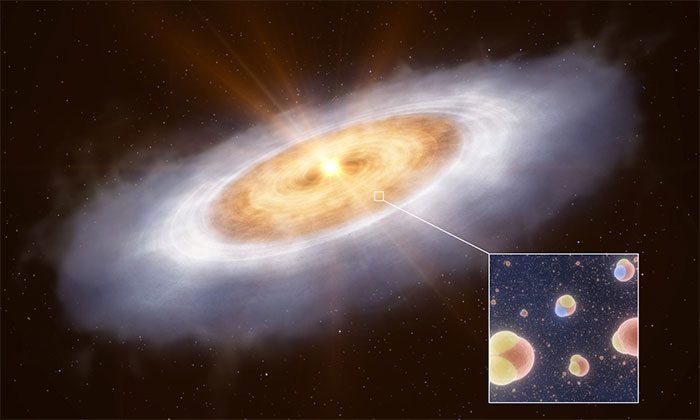A team of scientists led by the National Radio Astronomy Observatory (NRAO) in the United States has identified signs of a “source of life” in the protoplanetary disk of a young star named V883 Orionis.
According to Sci-News, the groundbreaking data was recorded by the Atacama Large Millimeter/submillimeter Array (ALMA), the most powerful radio observatory in the world, a collaborative project between the United States and Chile located in the Atacama Desert.
“The divine eye” of ALMA has provided a highly valuable sign supporting the hypothesis that water on Earth—the “cradle” of life—existed even before the Sun officially formed. Water is one of the key factors that determine whether a planet is habitable.
Molecules that act as a “nursery” for life were also analyzed through the presence of the heavy isotope of hydrogen, deuterium.

Graphic illustrating V883 Orionis and valuable molecules acting as a “nursery for life” in its protoplanetary disk – (Image: ESO)
Because regular water and heavy water containing deuterium form under different conditions, the ratio of these can be used to trace the timeline and determine where water was formed.
For example, the ratio in certain comets in the solar system has been found to be similar to that of Earth, suggesting that comets may be similar to those that once brought water to the early Earth.
A surprising finding in the new research is that the ratio of regular water molecules to deuterium-rich water in the environment around V883 Orionis is similar to that of our solar system and Earth.
This evidence suggests that Earth’s water predates the Sun and is similar to that found in distant worlds, indirectly supporting the hypothesis that life and all essential elements for life on Earth today were seeded in the interstellar medium. In other words, we are extraterrestrial beings who have been seeded on Earth by asteroids and comets, along with what is necessary for our survival.
In the environment around V883 Orionis, there could be other “Earth-like worlds” being formed in the same way.
Astronomer Margot Leemker from Leiden University in the Netherlands, a co-author of the study, explained: “Most of the water in the interstellar medium forms as ice on the surface of small dust grains in molecular clouds. When these clouds collapse under their own gravity and form young stars, water will end up in the disks surrounding them.”
“Eventually, the disks evolve, and the icy dust grains coalesce to form a new ‘solar system’ with planets, comets…” he added, explaining how the worlds in the Orion constellation and other worlds, including ours, came to exist with water.
The study has just been published in the scientific journal Nature.


















































